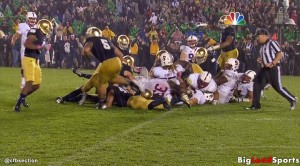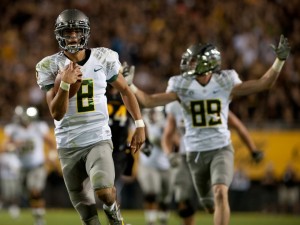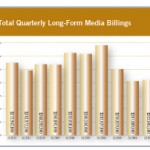Were the expectations outsized? Obviously. Are the results – to this point – acceptable? No.
As I look ahead to next Saturday at what – win or lose – was to be a shining moment for a USC football program that was laughing in the face of overwrought NCAA sanctions to compete for a national championship only three years after beginning its probationary period, it’s a shame that the luster has come off the battle with Oregon. It’s even a bigger shame that Lane Kiffin’s USC football team is wholly responsible for that fact.
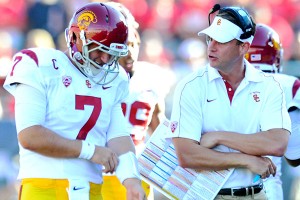
Matt Barkley made some mistakes in the loss to Arizona, but nothing to compare to Lane Kiffin’s tactical miscalculations.
Yesterday’s absurd 39-36 loss at Arizona was the ultimate antithesis of the Trojans’ epic 38-35 win at Oregon a season ago – the game that set the expectations for the 2012 team. And while the players on the field deserve their share of the blame for the mistakes that handed the game to a decent but outmanned Wildcat team, many of those mistakes trace back directly to the head coach’s office. And the fact that USC could have made all of those errors and still should have won the game going away with even the simplest of coaching decisions lies directly at the foot of Kiffin’s desk.
During the Pete Carroll era, one of the defining characteristics of USC football was the mentality – from the game’s opening kickoff – that we are going to play our game and you, the opponent, will have to adjust to what we do. It’s become clearer, week by week in 2012, that that theory is completely out the window under Kiffin. Whether you want to call it overthinking, timidity or (in the kindest possible evaluation) a coach looking to protect his players because of the depth issues facing a team on sanctions, USC has consistently showed the desire to adjust its game to minimize the perceived strengths of its more dangerous opponents. While in-game adjustments to the reality of what’s happening on the field are normal (and a place where Carroll-coached teams continue to regularly outshine Kiffin-coached squads), changing a team’s personality week to week is a risky way to coach football.
Not only that, but in games like yesterday – a game where the USC offense’s personnel advantage over its counterparts on the Arizona defense was massive – it reeks of conservatism. Late in yesterday’s game, I tweeted: “Defining difference between Carroll and Kiffin: given a chance for the killshot, Carroll always took it. Kiffin is becoming JRIII.” While, to the uninitiated, this reference to former USC coach John Robinson might look strange, Kiffin’s effort – both early and late in yesterday’s loss – brought the sometimes overly conservative Robinson to mind.
From the get-go, it was clear that USC was interested in running clock and trying to keep the Arizona offense off the field for long stretches. The Trojans continually put themselves in third-down situations early on and, while they were more proficient in those situations yesterday than they’ve been most of the season, needlessly extended drive after drive. When those initial three USC drives, all of which reached inside the Arizona 25-yard line, ended with a pair of turnovers and a failed fourth-down pass, USC found itself down 10-0.
Tell me: what’s the point? If you’re able to score at will against a defense, why not score as simply and quickly as possible and put the onus on the opposition’s offense to keep up with you? Why concede – immediately – that you’re playing Arizona’s game? Why show that you’re so concerned with what Arizona is capable of on offense that – instead of taking advantage of a defense that is comparable in talent and depth to Colorado, sadly – you’re going to slow down and minimize the capabilities of your offensive talent? Why do you want to run more plays, thereby giving your questionably-disciplined team more chances to commit silly, drive-stopping penalties? Why give the officials, who know USC’s M.O. now and come into games on alert for the most minor Trojan miscue, more chances to throw those flags? Why does it take a quarter-and-a-half to fully realize that Arizona couldn’t keep up with passes down the field to Marqise Lee (and for that matter, Robert Woods) if it had 14 players on the field? Why not just go for the jugular? When I watch Lee play, I see a player who completely believes he has a chance to score on every play. It’s inspiring to see that confidence and desire in a player. And, yesterday, he was actually in a position where he was as close as he’ll ever be to being 100-percent correct in that belief. It’s Lee’s kind of confidence that points out Kiffin’s timidity even more clearly.
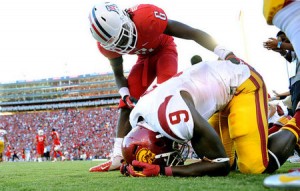
If ever there was a player who shouldn’t have been disappointed in a game, it was Marqise Lee after his epic performance in Saturday’s loss in Tucson.
So, after 20 minutes of screwing around and trying to “protect the defense,” Kiffin finally realizes, “Hey, let’s get the ball downfield, especially to Marqise, and see if they can stop it.” Great! Almost immediately, USC takes off on a 28-3 run – overcoming even the dumbest of penalties (and, by the way, who knew that if you run fewer plays to score, you have fewer opportunities to commit the dumb penalties that are becoming one of this USC team’s trademarks) – and takes total control of the game early in the third quarter. Lee is setting records with every catch, and the USC defense (much to Kiffin’s consternation, I imagine) is actually performing better through the game’s first 40 or so minutes when the Trojan offense is pumping the ball up and down the field.
And then? Kiffin reverts to the formula that had put USC in a 10-0 hole in the first place. You saw it. I saw it. Instead of going for the kill – and USC had two possessions with a chance to take what would have been a deflating 35-13 lead, likely ending all Arizona hopes – the Trojans almost voluntarily removed Lee from the offense, got conservative (aside from one lonely deep shot to Woods that Barkley overthrew) and went cold. Before Kiffin readjusted, Arizona was not only back in the game but in the midst of a 26-0 run of its own that would put USC in Hail Mary mode at the end of a game it should have rightfully won going away – even with the ridiculous penalties and turnovers that haunted the performance.
This was the outcome Kiffin and the Trojans barely avoided two weekends ago in Seattle, when some timely hits by the defense stunted Washington’s burgeoning momentum while the USC offense played it needlessly safe. Those timely hits weren’t forthcoming yesterday, and a defensive performance that, through about 40 minutes, was looking rather solid fell apart against the performance of a much better quarterback operating a much more creative offense than UW’s Keith Price.
So, aside from the disappointment the loss to Arizona heaps on top of (what at the time felt like) a more acceptable defeat at Stanford, where the Trojans were simply outplayed over the course of 60 minutes, what does 6-2 (with a very high likelihood of 6-3 a week from now, facing must wins against Arizona State and UCLA just to get into the Pac-12 title game) tell us about USC and Kiffin?
For one, it tells me the image of Kiffin as a master of “Eff You” football, amusingly posited on a regular basis in Zack Jerome’s fantastic and comedic Arrogant Game Previews and Recaps, is becoming more and more difficult to back up. Certainly, the journalists who cover college football are on alert for any Kiffin error, be it on the field or off. The mistakes he made in his early days as a coach with the Raiders and Tennessee haunt him, though he’s grown more mature, every time anything remotely questionable (like last week’s ridiculous number-switching “controversy) comes up. But how Kiffin has coached the 2012 USC team leaves him open to even more criticism, for how the Trojans have played and how Kiffin has coached are far from the brand of “arrogance” that has long been a positive for USC football. The aura of timidity turns that “arrogance” – read here as the Carroll Way of “Here’s what we’re gonna do. You figure out how to stop it.” – to a perception of petulance and immaturity. I’d far prefer the Kiffin of Jerome’s columns to the one operating on the USC sideline this season.
When you toss in the ridiculous number of personal foul and unsportsmanlike conduct penalties committed by USC – even supposed team leaders – that perception grows. There is no excuse for nearly all of those penalties – especially at this point – but to see a captain like T.J. McDonald take an obvious taunting penalty on the game’s THIRD DEFENSIVE PLAY (a penalty that turned a three-and-out for Arizona into an eventual touchdown), well, that’s just plainly a failure by the player to learn. And who do we look at first when a player fails to learn such a lesson? His coaching staff.
Here’s the reality: Lane Kiffin likely will be USC’s coach through the 2014 season at the very least. With a 24-9 mark over 2 ½ tumultuous and sanctioned seasons, there’s no way (at this point) for the USC athletic department to sell that Kiffin is unfit for duty. However, with key leaders like Barkley, McDonald and Khaled Holmes now down to their final full month as Trojan footballers, Kiffin faces a clear turning point in his career over the next 13 months. This is a team that could literally finish the season anywhere between 6-7 and 12-2. It’s physically capable of beating any team left on the schedule – but its lack of a true personality and error-prone ways also mean that the Trojans can be beaten by every team left on the schedule. And, especially after yesterday, can anyone rightfully figure out what to expect from the Trojans in 2013?
Kiffin needs to decide who HE is going to be as a head coach. By making that decision, which is one that will require a big jump in maturity and self-searching, only then will he be able to tell us what the real personality of the USC Trojan football program will be under his control. Burying your head in a play card while the season slips away because of your timidity and your team’s lack of self control is not going to cut it. This is a team that’s clearly in search of a leader, and Kiffin hasn’t gotten the job done on that score through the season’s first eight games.
Look, Kiffin sure as hell isn’t Pete Carroll (not many are). But – even with a performance like yesterday’s that was mindful of the late 1990s USC program – he isn’t quite Paul Hackett either. Yet. He’s too young of a coach – too unfinished a product – to be tossed aside that blithely. But, he’s not the coach at a mid-level school working his way up (he could have stayed at Tennessee if that was the gig he wanted). He’s the coach of the premier college football program on the West Coast; the only football program west of Texas that has any respect on a national level. It may not be fair, but he needs to become a finished product quickly or risk heading down the Hackett Highway.
How Kiffin and the Trojans respond to Saturday’s brutal, senseless and needless loss over the next four weeks will write the first chapter in one of two books – Kiffin’s ultimate demise at Troy, or the beginning of a truly new era of USC football personified by a more steadfast and professional young coach.

